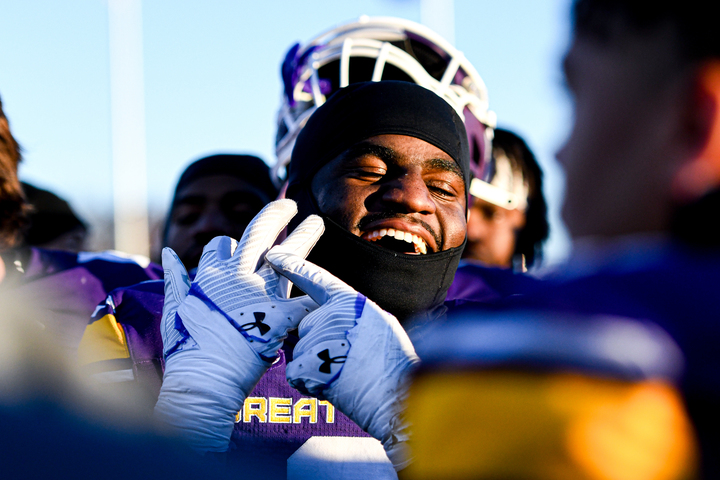No two days of training are exactly the same for Nathan Schrimsher.
His challenge, as a modern pentathlete, is to optimize his time to allow himself to become the best possible fencer, swimmer, equestrian, runner and shooter.
A typical training day starts at 8 a.m. and ends at 5 p.m., with breaks for lunch and recovery. He completes three or four practices in a given day, in addition to weight training.
“Pentathletes become pretty good at time management,” Schrimsher said.
He discussed how he trains for the modern pentathlon during a telephone interview from the U.S. Olympic Training Center in Colorado Springs.
Fencing
The opening event is a round-robin fencing competition with a single touch deciding each bout.
Modern pentathletes at the U.S. Olympic Training Center attend fencing practices on Mondays, Wednesdays and Fridays at 8 a.m. for about two hours.
Sports
In partnership with NBC Sports Philadelphia
Practices focus on footwork, as well as on the mental aspect of the sport.
“Fencing is like a game of chess,” Schrimsher said. “You’ve got to read your opponent and know what you’re capable of doing.”
Czech Republic’s David Svoboda, the Olympic gold medalist at the 2012 Games, won 26 of his 35 bouts in London. With so many bouts, competitors need to learn how to react to losses.
“If you get hit, then you get hit,” Schrimsher said. “You have to move on.”
Swimming
Next is the swimming event with heats of 200m freestyle races.
Swimming is Schrimsher’s best event. But that does not mean he enjoys jumping into the pool for training.
“It’s just you and the black line at the bottom of the pool,” Schrimsher said.
Schrimsher typically schedules three or four swim workouts per week. But if wants to spend more time training for another event, he feels confident enough in his swimming ability to occasionally skip a session.
Fellow U.S. pentathlete Logan Storie pushes Schrimsher to get faster. Storie, who swam in college for the University of Florida, is the modern pentathlon world record holder in the 200m freestyle swim.
“He makes us all better,” Schrimsher said. “I’m always seeing his bubbles and his feet way ahead of me in the pool.”
Horse riding
The third event challenges competitors to clear 12 obstacles on an unfamiliar horse.
Modern pentathletes have just 20 minutes to get to know their horses at the Olympics.
“You never know what type of horse you are going to get,” Schrimsher said.
To practice riding unfamiliar horses, Schrimsher and his U.S. teammates travel annually to an equestrian facility in Palm Springs, Calif. They start on a horse they have never met before. Then halfway through practice, they switch and ride a new horse.
Schrimsher tries to change his personality to match the temperament of the new horse. He communicates using his legs and hands, and even tries to talk to the animal.
“It’s another tough mental sport,” Schrimsher said. “You have to control a 1,200 pound animal that has its own brain and wants to do its own thing.”
Some horses are hyper. There was a frightening moment at the 2012 Olympics when South Korea’s Hwang Woojin was nearly injured after losing control of his horse.
But other horses are calm, which makes it easier for the rider to establish a connection.
“When it’s a perfect match, it feels like you are flying over the jumps,” Schrimsher said. “I love that feeling.”
Running and shooting combined event
The final event features a 3200m race(four laps of 800m) with four shooting stops, where competitors shoot a laser pistol at a target 10m away.
Running and shooting are together in competition, but Schrimsher trains for them separately.
He considers running to be his weakest event. To improve, he runs between five to seven miles per day, with one or two rest days per week.
On Tuesdays and Thursdays, he runs with his U.S. teammates. The rest of the week he trains on nearby trails with his brother, Lucas, who is also a pentathlete. They do fartlek workouts, running continuously at different speeds.
“Running is hard for me,” Schrimsher said. “I have to take care of my body so I don’t get injured.”
Schrimsher, who grew up on a ranch in New Mexico, learned to shoot a rifle before he could swim. He now considers shooting to be one of his strongest events, along with swimming.
He spends less time training for shooting than any other event, practicing no more than two hours per week. His main goal is repetition, in order to get used to the weight of holding the two-pound laser pistol with his arm fully extended.
“Two pounds might not sound like a lot,” Schrimsher said, “but it will make your arm feel fatigued quickly.”



